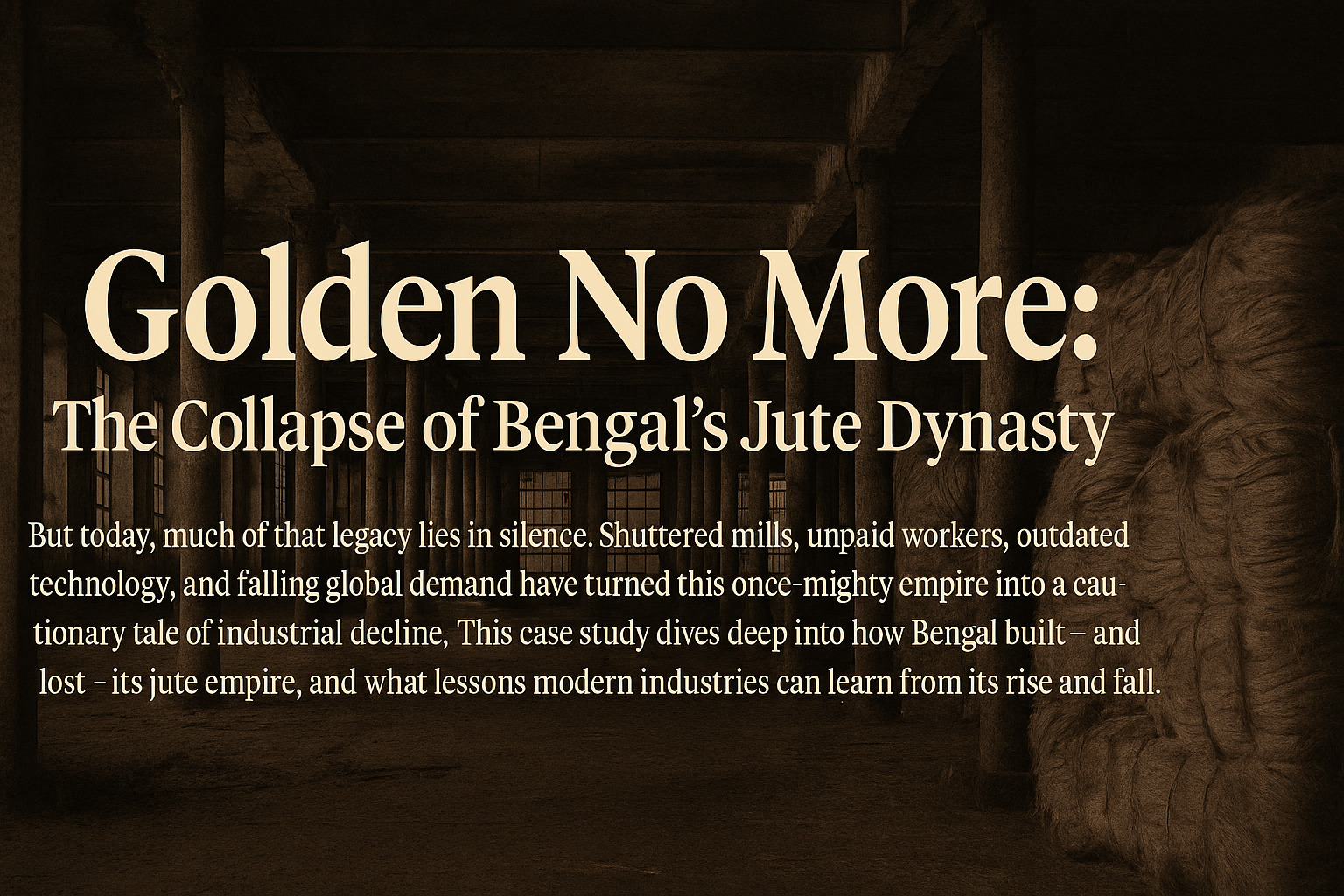Don't miss this exciting offer — contact us today and make it yours!

Once hailed as the “Golden Fibre of India,” jute was the pride of West Bengal, a symbol of agricultural wealth, industrial strength, and colonial-era export dominance. From the banks of the Hooghly River to mills across Howrah, Titagarh, and Naihati, Bengal’s jute industry employed lakhs and exported to every corner of the world.
But today, much of that legacy lies in silence. Shuttered mills, unpaid workers, outdated technology, and falling global demand have turned this once-mighty empire into a cautionary tale of industrial decline.
This case study dives deep into how Bengal built — and lost — its jute empire, and what lessons modern industries can learn from its rise and fall.
Colonial Bengal was the jute capital of the world.
The first jute mill was established in Rishra (1855); by the early 1900s, Bengal had over 60 mills, employing 3,00,000+ workers.
Jute products—gunny bags, ropes, carpets, textiles—were exported to Britain, the US, Africa, and Southeast Asia.
The industry drove urban growth, funded railways, and became the economic backbone of Eastern India.
Jute wasn’t just a crop. It was a culture, a community, and a currency.
Partition in 1947 created a paradox: most of the jute was grown in East Pakistan (now Bangladesh), but mills remained in India.
This led to supply chain chaos, raw material shortages, and increasing dependence on imports.
While the world moved toward synthetics and automated looms, Bengal’s mills remained stuck in pre-independence-era machines.
Lack of R&D, innovation, and investment made jute mills globally uncompetitive.
Bengal’s jute mills became hotbeds of trade union strikes, political interference, and wage disputes.
Frequent lockouts discouraged private investors and foreign buyers.
The global market shifted to plastic, polypropylene, and cheaper fibres.
Government policies failed to promote jute diversification or create modern branding campaigns like “Khadi” or “Make in India”.
Many mills became state-run and debt-ridden.
Profiteering, mismanagement, and fake subsidies plagued the system, leading to rampant closures.
2.5 lakh+ workers affected directly, with another 10 lakh in jute farming and trade.
Whole towns like Titagarh, Shyamnagar, and Bhadreswar lost their economic identity.
Generations of families tied to jute had no modern reskilling pathways, leading to unemployment, migration, and poverty.
Government offers Minimum Support Price (MSP) to farmers.
Launched Jute Smart portal for mill procurement and digitized trade.
Mandates use of jute sacks for food grains and sugar.
Ensures partial demand for domestic jute mills.
Startups and design institutes promote jute handicrafts, bags, geotextiles, and decor.
Eco-conscious brands see potential in jute as a plastic alternative.
NGOs and rural co-operatives run training on jute-based apparel and home products.
Some international buyers from Germany, Japan, and UAE are returning with sustainable goals.
Out of 70+ mills, only 25–30 operate regularly.
Many are burdened with outdated machinery, low productivity, and debt.
A few new-age players like Bally Jute, Gloster Limited, and Hooghly Mills are trying to pivot to exports and value-added goods.
Bengal’s jute industry shows how dependence on legacy without innovation is a risk.
It highlights the cost of ignoring skilling, branding, and diversification.
Also reveals how climate-conscious products (like jute) can find new life if supported by design, tech, and global storytelling.
Heritage Isn’t Enough Without Reinvention
→ Modern consumers want tradition reimagined, not just repeated.
Green Is Gold — If Marketed Right
→ Jute is eco-friendly, biodegradable, and trendy. It needs a new-age narrative.
Build Around Ecosystems, Not Just Factories
→ The fall wasn’t just industrial. It was ecosystem-wide — from farmer to freight.
The fall of Bengal’s jute empire is not just a story of industry — it’s a tale of missed foresight, fragile systems, and changing global demand. Yet, the fibre still holds hope.
In a world drowning in plastic, the “golden fibre” can be Bengal’s green weapon — if it’s paired with innovation, design, and a strong revival story.